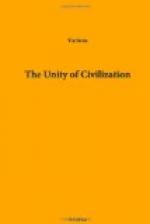The exhilarants show the same geographic control; with the olive culture go the wines and brandies of the south; with the forest culture, the ciders and the cherry brandies of Central Europe; with the copious cereals and meadow-grass, the beers and whiskies of the North. In details, of course, the distribution of types is intricately confused; but the main outline is clear; and we reach a first glimpse of a coherent European culture, on the almost animal plane of regional foodquests.
RACE, LANGUAGE, AND CULTURE AS FACTORS OF UNITY
Precedence has been given in our inquiry to the mere animal struggle of man with nature for bare subsistence, for two distinct reasons. The first is economic, namely, that just because this struggle is without qualification that of a highly intelligent animal species to maintain itself under these or those conditions, it is one which befalls equally every breed or race of that species which is ever exposed to those conditions; and further, is no more mitigated by considerations of language than by considerations of race. The second reason is historical or archaeological. The spread of the Bread culture is dated so far back in the history of man in this region, as to make it certain that it preceded not merely the spread of the prevalent Indo-European group of languages, but even the present distribution of racial types. It certainly reached Italy, and the Atlantic seaboard as the British Isles, before the brachycephalic ‘Alpine’ men arrived there; and still more before the Boreal invasions of Britain and the opposite coasts. Indeed, it would be truer to say that in general each breed of man which has changed its distribution has had to adopt sooner or later the types of culture appropriate to the regions into which it has penetrated, than to associate the spread of any element of culture so fundamental as the food-quest with the migrations of any racial type.




